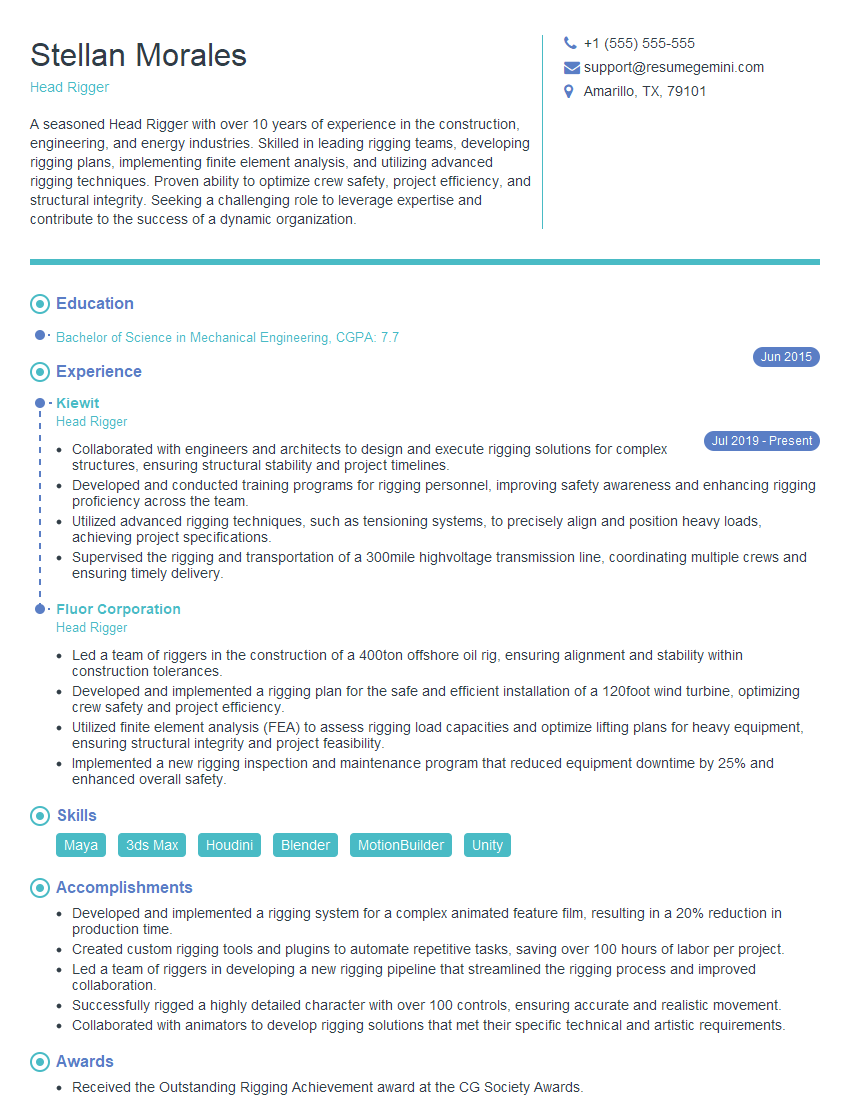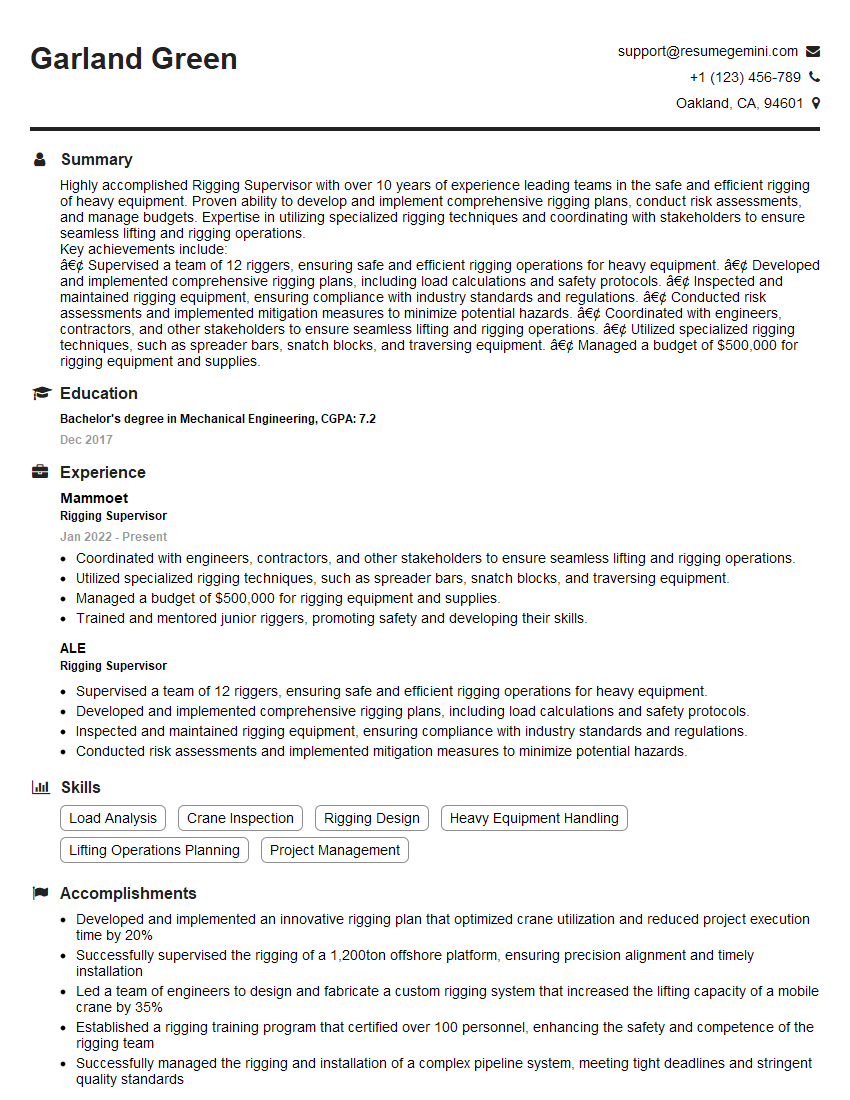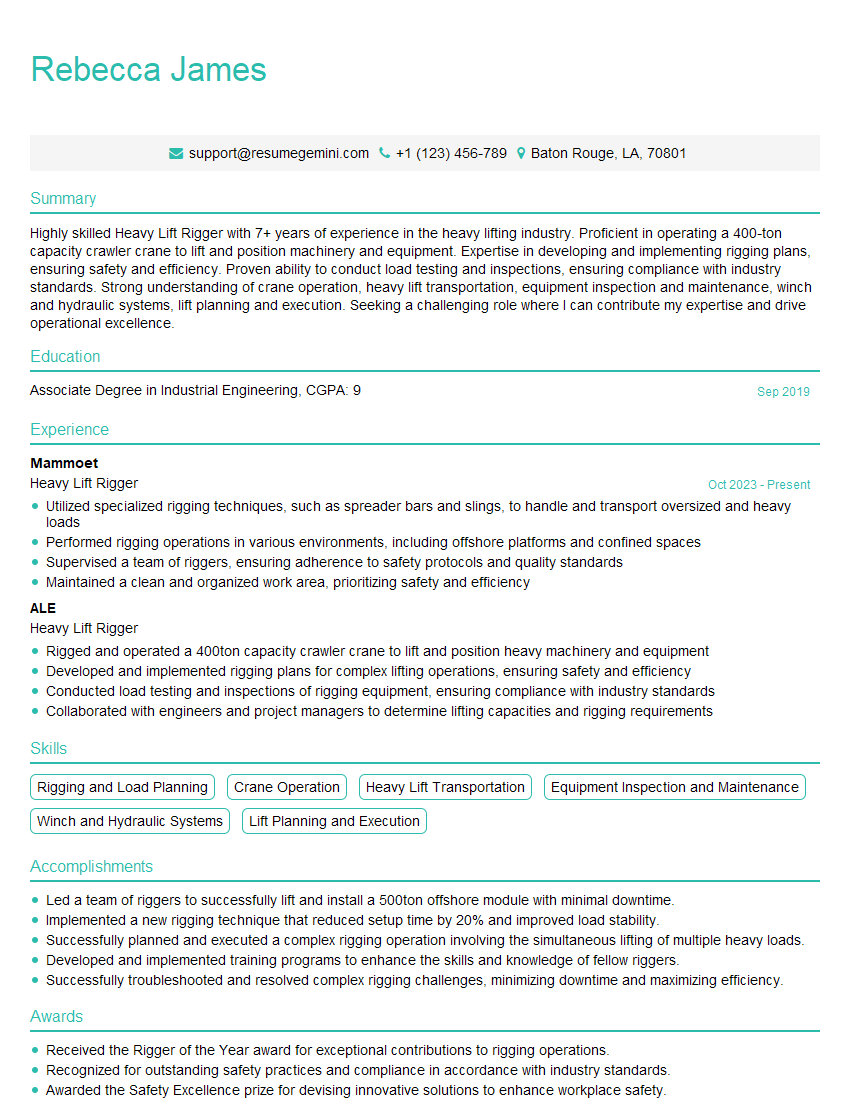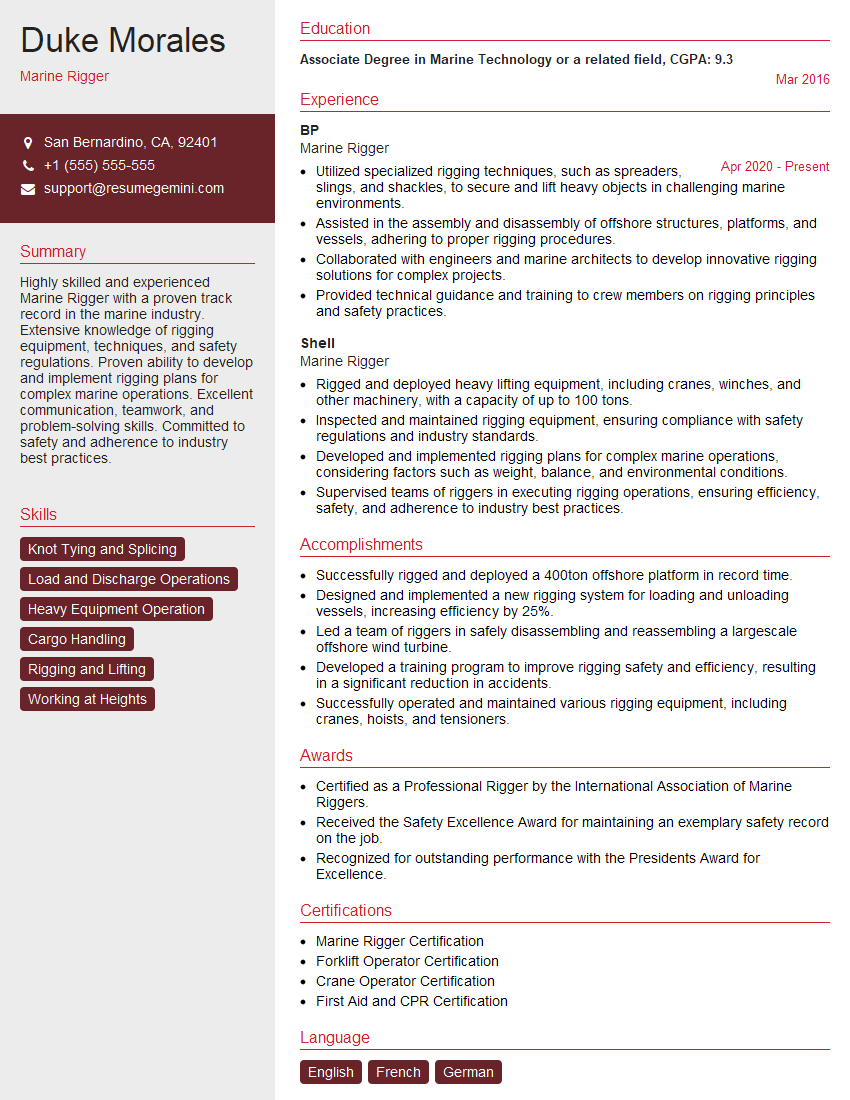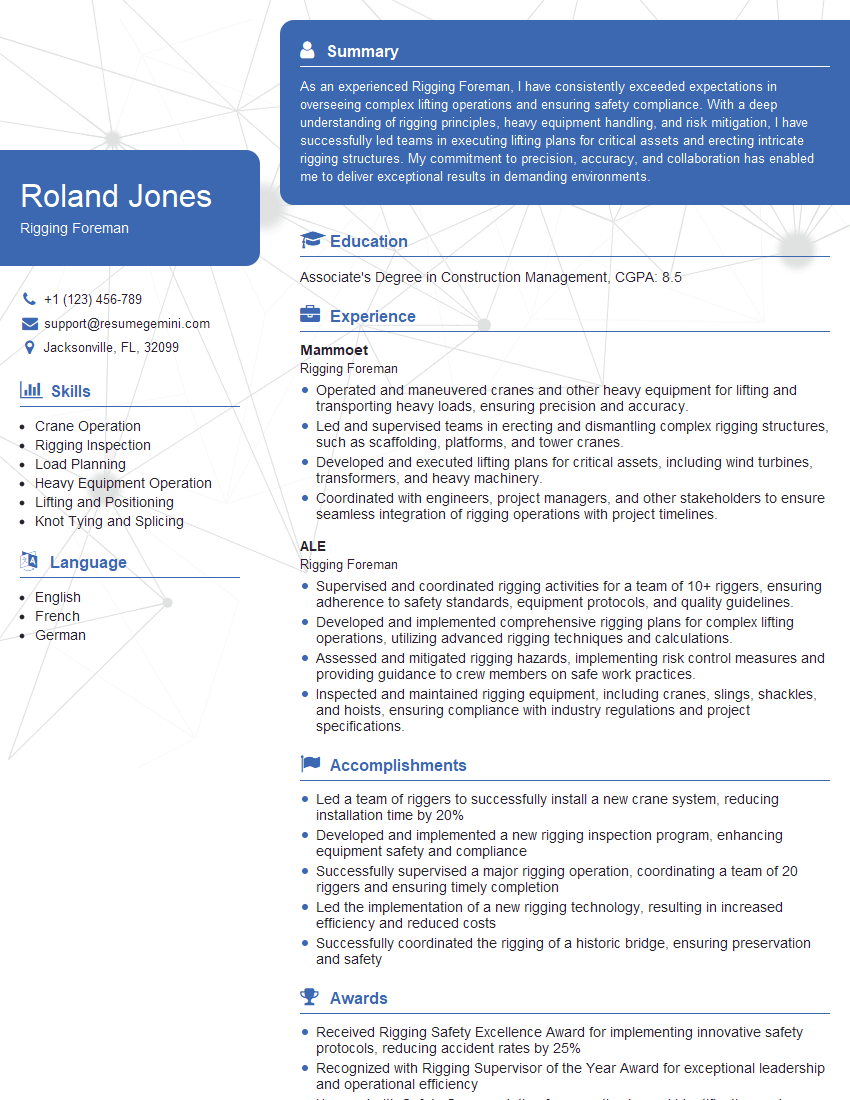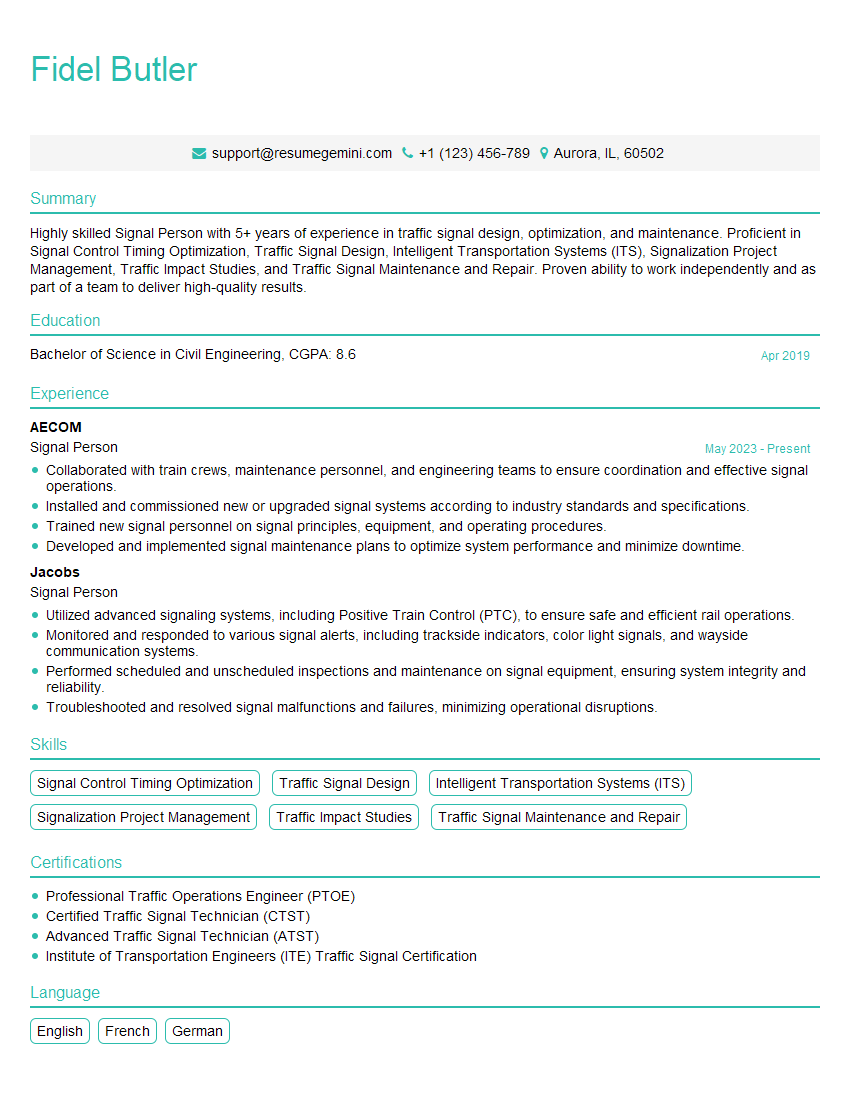Preparation is the key to success in any interview. In this post, we’ll explore crucial Rigging and Tackle Setup interview questions and equip you with strategies to craft impactful answers. Whether you’re a beginner or a pro, these tips will elevate your preparation.
Questions Asked in Rigging and Tackle Setup Interview
Q 1. Explain the difference between static and dynamic rigging.
The key difference between static and dynamic rigging lies in how the load is handled. Static rigging involves a fixed setup where the load remains stationary or moves very slowly. Think of it like building a scaffold – once it’s up, it’s largely immobile. The forces are predictable and relatively constant. Dynamic rigging, on the other hand, involves significant movement and acceleration of the load. Imagine lifting a heavy component with a crane; the load accelerates upwards, decelerates during placement, and potentially swings. This introduces dynamic forces, significantly impacting the stress on the rigging components. Understanding this difference is crucial for selecting appropriate equipment and safety factors, as dynamic rigging necessitates stronger components and more robust safety measures to account for the fluctuating forces.
Q 2. Describe the various types of slings and their applications.
Slings are the workhorses of lifting operations, and several types cater to different needs. Round slings, made of synthetic fiber (e.g., polyester, nylon), offer flexibility and conformability, making them suitable for various load shapes. They’re relatively easy to handle and are less prone to sharp edges causing damage. Endless slings form a continuous loop, enhancing durability and ease of use. Web slings are flat and made of tightly woven synthetic material; they are strong and easy to inspect. Chain slings, constructed from high-strength steel, are robust and suitable for harsh conditions, but require careful inspection for wear and elongation. Finally, wire rope slings offer exceptional strength and durability but require more careful handling and inspection due to the possibility of fraying or breakage. The choice of sling depends heavily on the load’s shape, weight, and environment, always considering the SWL and the sling’s condition.
Q 3. How do you calculate the safe working load (SWL) of a lifting assembly?
Calculating the Safe Working Load (SWL) of a lifting assembly isn’t simply looking at the SWL of individual components. It’s a complex process that considers several factors. First, you need the SWL of each component – the slings, shackles, hooks, and the lifting equipment itself. The weakest link determines the overall SWL of the assembly. The configuration of the lift also matters significantly. For example, using two slings in a vertical configuration shares the load equally, while a bridle configuration, where slings angle outwards from a central point, reduces the effective SWL of each sling due to the angled forces. Angle and sling configuration must be calculated and included in your total SWL. Additionally, safety factors are applied to account for unforeseen circumstances or variations in material strength. Regulations and manufacturer specifications should be strictly followed. Failure to accurately calculate SWL can lead to catastrophic equipment failure.
Example: If you have two slings each with a 10,000 kg SWL used vertically, the assembly’s SWL is 20,000 kg, but if these are used as a bridle with a 60-degree angle, the SWL will be significantly lower and requires detailed calculation.
Q 4. What are the different types of knots used in rigging and their appropriate uses?
Several knots are indispensable in rigging, each serving a unique purpose. The bowline is a classic, forming a secure loop that won’t slip. It’s ideal for attaching a rope to an object or creating a running loop. The clove hitch is quick to tie and easily adjustable, making it great for temporarily securing a rope to a post or ring. The figure-eight knot serves as a stopper knot, preventing a rope from running through a pulley or a block. The bowline on a bight creates two loops at once, useful for creating a double sling. Crucially, understanding knot integrity is vital; a poorly tied knot can lead to catastrophic failure. Regular inspection and proper training on knot-tying techniques are essential for safe rigging practices.
Q 5. Explain the importance of pre-lift planning.
Pre-lift planning is paramount to a safe and efficient lift. It’s not just about moving a load; it’s about mitigating risks and ensuring everyone’s safety. This involves a detailed assessment of the load’s weight, dimensions, center of gravity, and any unique characteristics. The lifting equipment’s capabilities must be carefully considered, ensuring it’s adequately sized and suitable for the task. The rigging plan should specify the type and arrangement of slings, the attachment points, the lifting path, and any potential obstructions. A thorough risk assessment, including environmental factors like wind speed and ground conditions, is crucial. Detailed communication between the rigger, crane operator, and other personnel involved is also critical to prevent accidents. A well-executed pre-lift plan reduces the chances of accidents, delays, and damage.
Q 6. What safety checks should be performed before any rigging operation?
Safety checks are non-negotiable before any rigging operation. They are a critical step in preventing accidents and protecting lives. This begins with a thorough visual inspection of all components – slings, shackles, hooks, ropes, and the lifting equipment itself. Check for fraying, corrosion, damage, or any signs of wear and tear. Ensure all components have legible markings indicating their SWL and that these are within safe limits for the job. Verify the proper functioning of the lifting equipment – the brakes, the hoist mechanism, and any safety devices. Confirm the load is properly secured and centered to prevent swinging or imbalance. A final check involves communicating the lift plan to all personnel involved, ensuring everyone understands their roles and responsibilities. It’s better to delay a lift due to safety concerns than to proceed with a potential risk.
Q 7. Describe your experience with different types of lifting equipment (cranes, hoists, etc.).
Throughout my career, I’ve worked extensively with various types of lifting equipment, including tower cranes, mobile cranes, overhead cranes, and chain hoists. My experience with tower cranes encompasses large-scale construction projects, requiring meticulous planning for lifting heavy components at significant heights. With mobile cranes, I’ve been involved in industrial settings, handling diverse loads such as machinery, containers, and raw materials, demanding proficiency in load calculations, rigging techniques, and safe operating procedures. Overhead cranes are familiar territory within factory environments, where I’ve overseen the lifting of various components within assembly lines. Finally, my work with chain hoists spans smaller-scale operations to support assembly and maintenance tasks, emphasizing precision and safety in more confined areas. This varied experience provides a comprehensive understanding of the strengths and limitations of each type of equipment and the necessary safety procedures for each.
Q 8. How do you identify and mitigate potential rigging hazards?
Identifying and mitigating rigging hazards is paramount to ensuring safe lifting operations. It’s a multi-step process that begins long before the lift itself. We start with a thorough pre-lift planning phase, including a detailed risk assessment.
- Inspection: A meticulous inspection of all rigging hardware – shackles, hooks, slings, wire ropes, and the load itself – is crucial. We look for signs of wear, damage, corrosion, or deformation. Any component showing even minor damage is immediately removed from service.
- Load Analysis: Determining the weight, center of gravity, and the load’s characteristics (e.g., shape, fragility) is essential for selecting appropriate rigging equipment and techniques. Underestimating the load is a major hazard.
- Environmental Factors: We account for environmental conditions like weather (wind, rain, temperature extremes), ground conditions, and the surrounding workspace. High winds, for instance, could significantly impact stability and create unsafe conditions.
- Safe Working Loads (SWL): Every piece of rigging equipment has a specified SWL. We never exceed this limit. Using a piece of equipment beyond its SWL risks catastrophic failure.
- Personnel Training and Communication: Ensuring all personnel involved are properly trained and understand their roles is vital. Clear communication channels must be established to coordinate the lift effectively.
For example, during a recent project involving the lifting of a heavy transformer, we identified potential hazards associated with its unusual shape and center of gravity. This led us to utilize specialized slings and a more controlled lifting technique to mitigate the risk of imbalance and swinging.
Q 9. Explain the importance of using a tag line during lifting operations.
A tag line is a secondary, lighter-duty rope or wire rope used to control the load during lifting operations. Its importance is multifaceted:
- Guidance and Control: The tag line helps guide the load smoothly, preventing swaying or uncontrolled movement. Imagine trying to lift a large, unwieldy object without any assistance – it would be difficult to keep it stable.
- Emergency Control: If the primary lifting mechanism fails, the tag line provides a backup means of controlling the load, preventing a potentially dangerous fall.
- Precise Positioning: The tag line allows for precise positioning of the load, especially in confined spaces or when placing it into a specific location.
- Preventing Swings: A tag line helps mitigate the effect of wind or other external forces that could cause the load to swing dangerously.
In one instance, a sudden gust of wind nearly caused a heavy steel beam to swing wildly. Thankfully, the tag line prevented a serious accident, smoothly guiding the beam back to a stable position.
Q 10. What are the legal requirements and regulations related to rigging in your region?
(Note: Legal requirements vary significantly by region. This answer provides a general overview and should not be considered legal advice. Always consult local and national regulations.)
Rigging operations are subject to stringent safety regulations in most jurisdictions. These often include:
- Compliance with OSHA (or equivalent): Occupational Safety and Health Administration (OSHA) standards (or their equivalent in other countries) provide a comprehensive framework for safe rigging practices, covering aspects such as equipment inspection, worker training, and hazard prevention.
- Licensing and Certification: In many areas, riggers are required to hold specific licenses or certifications demonstrating their competency and knowledge of safe rigging procedures.
- Regular Inspections: Rigging equipment must undergo regular inspections to identify and address potential problems before they lead to accidents. Documentation of these inspections is usually mandatory.
- Accident Reporting: Any accidents or near misses involving rigging must be reported to the appropriate authorities.
- Specific Regulations for Certain Industries: Industries like construction, manufacturing, and oil and gas often have additional, more specific regulations related to rigging and lifting operations.
Ignoring these regulations can lead to hefty fines, operational shutdowns, and, most importantly, serious injury or fatalities.
Q 11. Describe your experience with different types of rigging hardware (shackles, hooks, etc.).
My experience encompasses a wide range of rigging hardware, including:
- Shackles: I’m proficient in using various types of shackles – bow shackles, D-shackles, and screw pin shackles – and understand their respective strengths, limitations, and proper applications. I always ensure that shackles are properly sized and inspected for damage before use and that the pin is fully engaged and secured.
- Hooks: I’m familiar with different hook designs, including single hooks, double hooks, and eye hooks. I understand the importance of inspecting hooks for cracks, bends, or excessive wear and tear. I always ensure hooks are correctly attached to the sling and the load is properly distributed.
- Slings: I have extensive experience with various sling types including wire rope slings, chain slings, and synthetic web slings. I’m knowledgeable about their respective load capacities, appropriate application, and the importance of proper inspection for wear, damage, or fraying.
- Other Hardware: My experience extends to other rigging hardware such as turnbuckles, wire rope clips, and spreader beams, understanding their role in load distribution and stability.
For example, during the installation of a large industrial crane, I selected high-strength alloy steel shackles and wire rope slings specifically designed to withstand the considerable load. This detailed consideration ensured the integrity and safety of the operation.
Q 12. How do you ensure the proper communication and coordination during a rigging operation?
Effective communication and coordination are absolutely critical during rigging operations. This involves:
- Pre-Lift Meeting: A thorough pre-lift meeting involving all participants is essential. This meeting outlines the lift plan, assigns roles and responsibilities, and clarifies communication protocols.
- Hand Signals: Standardized hand signals are used to communicate instructions during the lift. All team members must be proficient in understanding and using these signals.
- Two-Way Radios: Two-way radios provide instant communication for coordinating the lift and addressing any unexpected issues that arise.
- Designated Signal Person: A designated signal person is crucial, acting as the primary communication link between the crane operator and the ground crew. Their responsibility is to ensure the crane operator receives clear and accurate instructions.
- Clear Communication Protocol: A formal and concise communication protocol should be established and clearly understood by all team members before the lift begins, addressing potential issues and how to handle them.
A clear example of this is our lift of a large piece of machinery. Using a designated signal person, hand signals, and two-way radios, we managed to lift and position the load precisely, avoiding obstacles within the constrained work area. This collaborative method resulted in a smooth and safe operation.
Q 13. Explain your understanding of load distribution and center of gravity.
Understanding load distribution and center of gravity is fundamental to safe rigging. The center of gravity (CG) is the point where the weight of an object is considered to be concentrated. Improper load distribution can lead to instability, resulting in swaying, tipping, or even catastrophic failure.
- Load Distribution: Proper load distribution ensures that the weight is evenly distributed across the rigging points. This prevents excessive stress on any single point of attachment, minimizing the risk of failure.
- Center of Gravity: The CG must be carefully considered when planning a lift. An object with a high CG is more prone to instability than one with a low CG. We use techniques such as spreader beams to lower the CG and improve stability during lifts.
- Calculations and Planning: Accurate calculations are crucial to determine the correct rigging points and ensure even load distribution. Planning ahead allows us to mitigate potential problems and optimize the lifting operation.
Imagine trying to lift a long, thin beam by attaching the sling only at one end – it would almost certainly rotate and create an unsafe situation. By considering the CG and properly distributing the load, we can ensure that the beam remains stable and controlled throughout the lifting process.
Q 14. Describe your experience working with various materials (steel, timber, concrete).
My experience includes working with various materials, each requiring specific rigging techniques:
- Steel: Steel is a common material in rigging. We use appropriate slings and hardware capable of handling steel’s weight and strength. We are mindful of potential sharp edges and burrs that could damage slings.
- Timber: Timber requires careful consideration due to its varying strength and potential for splitting or cracking. We ensure that proper lifting points are selected to avoid damage. Appropriate slings and techniques are employed to avoid crushing.
- Concrete: Concrete elements can be heavy and irregular in shape, requiring specialized rigging techniques and appropriate equipment to handle their weight and potential for fracturing. We often use multiple points of attachment to provide stability and control.
For example, during a construction project, we were tasked with lifting large prefabricated concrete wall sections. We used spreader beams and multiple high-strength slings to distribute the load evenly and prevent potential damage to the concrete. We carefully considered the shape and center of gravity of the sections to ensure a safe and stable lift.
Q 15. How do you handle unexpected situations or emergencies during a rigging operation?
Unexpected situations during rigging are part and parcel of the job. My approach is based on a proactive risk assessment and a systematic emergency response plan. First, I always prioritize safety. If I encounter an unexpected issue, like a component failure or a sudden change in weather, my immediate action is to halt the operation and assess the situation. This involves carefully evaluating the risks and potential dangers involved. Then, I communicate clearly and calmly with the team, ensuring everyone understands the problem and the plan of action. We’ll consider alternative solutions, perhaps using different equipment or adjusting the lifting technique. If the issue cannot be resolved safely on-site, I’ll consult with the supervisor or engineer for further guidance. Detailed documentation of the incident is crucial, including the cause, the remedial actions taken, and any lessons learned. For example, during a recent lift of a heavy transformer, a sudden gust of wind caused the load to swing dangerously. I immediately signaled the crane operator to stop the lift, secured the load with additional tag lines, and waited for the wind to subside before resuming the operation, documenting the incident thoroughly.
Career Expert Tips:
- Ace those interviews! Prepare effectively by reviewing the Top 50 Most Common Interview Questions on ResumeGemini.
- Navigate your job search with confidence! Explore a wide range of Career Tips on ResumeGemini. Learn about common challenges and recommendations to overcome them.
- Craft the perfect resume! Master the Art of Resume Writing with ResumeGemini’s guide. Showcase your unique qualifications and achievements effectively.
- Don’t miss out on holiday savings! Build your dream resume with ResumeGemini’s ATS optimized templates.
Q 16. What is your experience with different types of rigging inspections (pre-use, periodic, etc.)?
Rigging inspections are essential for ensuring safety and preventing accidents. I’m experienced with all types of inspections, including pre-use inspections, periodic inspections, and those triggered by specific events like near misses or equipment damage. A pre-use inspection is a thorough visual check performed immediately before each lift, covering all components, including slings, shackles, hooks, and the crane itself. I carefully look for any signs of wear and tear, damage, or deformation. Periodic inspections are more in-depth and scheduled regularly, often monthly or annually, depending on the frequency of use and the type of equipment. These inspections often involve detailed documentation, load testing, and sometimes specialist examination. For example, I’ve conducted many periodic inspections of wire ropes, noting wear, kinks, and corrosion. Any defects necessitate immediate repair or replacement. Post-incident inspections are carried out after any significant event, even a near miss, to identify the cause and to prevent future occurrences. My approach is always meticulous, ensuring that every component is thoroughly checked. All inspection findings are meticulously documented and reported.
Q 17. Explain the importance of proper documentation in rigging.
Proper documentation is paramount in rigging for several reasons. Firstly, it provides a record of the entire rigging operation, including the equipment used, the load details, the lifting plan, and the personnel involved. This is crucial for ensuring accountability and traceability if anything goes wrong. Secondly, it helps to identify and correct any potential safety hazards early on. Regular documentation allows for the tracking of equipment maintenance and inspection history, preventing equipment failure due to neglect. Thirdly, proper documentation is required for compliance with safety regulations and legal requirements. Documentation includes inspection reports, load calculations, risk assessments, and incident reports. I use a combination of digital and paper-based systems to record information, ensuring that all documents are easily accessible and auditable. For example, I meticulously document every rigging operation, including photos of the setup and any observations made during the inspection, making sure that the documentation is detailed and easy to understand for future reference.
Q 18. Describe your proficiency in using rigging software or calculation tools.
I’m proficient in using various rigging software and calculation tools. These tools are essential for accurate load calculations, ensuring that the rigging system can safely support the load. I frequently use software packages to design lifting plans, determining the appropriate sling angles, the number of slings required, and the capacity of each component. I’m also familiar with programs that perform stress analysis, ensuring that the rigging system is adequately designed to withstand the stresses it will be subjected to. For example, I recently used specialized software to calculate the stresses on a complex rigging system used to lift a large piece of industrial equipment. This ensured that the lift was executed safely and efficiently, minimizing the risk of any accidents.
Q 19. How do you ensure the compatibility of different rigging components?
Ensuring compatibility of rigging components is crucial for safety. Compatibility means ensuring that all components of the rigging system – the slings, shackles, hooks, and other hardware – are designed for the same working load limit (WLL), are compatible material-wise, and are in good condition. I always verify the WLL of each component and ensure that the chosen components can safely support the total weight of the load, accounting for factors like sling angles and safety factors. Before combining components, I carefully examine them for any signs of wear, tear, or damage. Using mismatched components or damaged equipment risks catastrophic failure. For example, using a sling with a lower WLL than the load weight would be a severe safety risk, leading to failure. I always check the manufacturer’s specifications and ensure all components are correctly identified and match specifications before the lift begins.
Q 20. What is your experience with different types of lifting techniques (vertical, horizontal, etc.)?
I have extensive experience with various lifting techniques, including vertical and horizontal lifts, as well as more complex angled or cantilever lifts. Vertical lifts are the most common, simply lifting the load straight up. Horizontal lifts involve moving the load laterally, often using specialized equipment like gantries or overhead cranes. Angled lifts require careful calculation and planning to ensure that the forces are distributed correctly across the rigging system. I’m proficient in choosing the right technique and equipment for each scenario. This includes selecting appropriate slings, using proper hitches, and ensuring that the load is balanced correctly. For instance, lifting a large, irregularly shaped object might require a specialized rigging arrangement, including multiple slings and potentially a spreader beam to ensure even weight distribution and prevent damage to the load. In each case, the chosen lifting technique must be matched to the specific load, its center of gravity, the environment, and the available equipment.
Q 21. Explain the importance of proper personal protective equipment (PPE) in rigging.
Personal Protective Equipment (PPE) is absolutely non-negotiable in rigging. It forms the first line of defense against potential hazards, protecting workers from injury. The specific PPE required will vary depending on the task, but generally includes hard hats to protect against falling objects, safety glasses or goggles to shield eyes from debris, high-visibility clothing to ensure visibility on site, and appropriate gloves to protect hands. In situations involving heights, fall protection harnesses are crucial. Furthermore, steel-toed boots are essential to protect feet from dropped objects or crushing injuries. I always insist on the proper use of PPE and ensure that all team members are properly trained and equipped before starting any rigging operation. Failure to wear appropriate PPE could result in serious injury or even death, which makes it a critical aspect of our safety procedures.
Q 22. How do you manage and mitigate the risks associated with working at heights?
Working at heights inherently involves significant risks, primarily falls. Mitigation starts with a robust risk assessment, identifying all potential fall hazards – uneven surfaces, inadequate edge protection, and unstable equipment. We then implement a hierarchy of controls:
- Elimination: If possible, we redesign the task to avoid heights altogether. For example, using ground-level equipment instead of aerial lifts.
- Substitution: Replacing a high-risk activity with a lower-risk alternative. Instead of manually hoisting a heavy object, we might use a crane.
- Engineering Controls: Implementing physical barriers like guardrails, safety nets, or fall arrest systems. This includes regular inspections to ensure their integrity.
- Administrative Controls: Developing and enforcing safe work procedures, providing comprehensive training, and utilizing permit-to-work systems for particularly hazardous tasks. This also includes regular toolbox talks highlighting common hazards and safe practices.
- Personal Protective Equipment (PPE): As a final layer of defense, we use harnesses, lanyards, and helmets, ensuring they’re properly inspected and worn correctly. Regular training on proper PPE usage is crucial.
For instance, during a recent project involving the installation of high-voltage equipment on a telecommunications tower, we implemented a comprehensive fall protection system including full-body harnesses, anchored lifelines, and a rescue plan. Regular inspections ensured all equipment remained functional and safe.
Q 23. What is your understanding of load charts and their significance?
Load charts are critical documents that specify the safe working loads (SWLs) for various rigging components like slings, chains, hooks, and shackles. They detail the maximum load each component can safely handle under different configurations (e.g., angle of lift). The significance lies in preventing catastrophic failures. Using equipment beyond its SWL can lead to component breakage, load drops, and potentially severe injuries or fatalities.
We use load charts extensively in planning and executing lifts. Before any lift, we determine the total weight of the load and then consult the load charts for each piece of rigging to ensure the selected equipment has a sufficient safety factor. This involves calculating the forces acting on each component, considering factors such as angles, attachment points, and environmental conditions.
For example, lifting a 5-ton transformer requires careful consideration of the sling angles. A chart will show that using two slings at a 60-degree angle each will result in higher stress on the slings compared to using four slings at a shallower angle. We select equipment whose SWL significantly exceeds the calculated load, incorporating an appropriate safety margin.
Q 24. How do you handle damaged or defective rigging equipment?
Damaged or defective rigging equipment is immediately removed from service. We have a strict policy of ‘if in doubt, throw it out.’ Any signs of wear and tear – frayed wires, cracks, dents, or distortion – automatically disqualify a component. We meticulously inspect all rigging before each lift and document the inspection findings.
Damaged equipment is clearly marked as unusable and segregated from operational equipment to prevent accidental use. It’s then sent for repair or, if beyond repair, responsibly disposed of according to industry regulations. Maintaining detailed records of damaged equipment, including the cause of damage and disposal method, is vital for safety analysis and preventing future incidents. We also conduct root cause analysis to understand why the damage occurred, implementing preventative measures where necessary.
In one instance, a minor crack was discovered on a shackle during a pre-lift inspection. Although seemingly insignificant, the shackle was immediately replaced, preventing a potential catastrophic failure during a heavy lift.
Q 25. Describe your experience with different types of rigging plans and drawings.
My experience encompasses a wide range of rigging plans and drawings, from simple lift plans for smaller loads to complex schemes for heavy industrial projects. I’m proficient in interpreting various types of drawings, including:
- 2D lift plans: These illustrate the positioning of equipment, the load path, and the attachment points.
- 3D models: These provide a more comprehensive visualization, particularly useful for complex lifts involving multiple pieces of equipment.
- Detailed component specifications: These specify the type, size, and SWL of each piece of rigging equipment.
- Critical lift plans: These are especially rigorous plans for high-risk lifts, including detailed risk assessments and emergency procedures.
I understand the importance of accurate drawings and clearly communicated information for safe and efficient lifts. Using detailed drawings enables careful planning, precise execution, and effective communication within the rigging crew.
Q 26. Explain your experience with specialized rigging techniques (e.g., heavy lifting, underwater rigging).
I have extensive experience with specialized rigging techniques. Heavy lifting frequently involves using specialized lifting equipment such as strand jacks, hydraulic gantries, and large-capacity cranes. This requires meticulous planning and coordination to account for the load’s size, weight, and center of gravity, and detailed analysis of the crane’s capacity and stability. Safety considerations are paramount, employing multiple safety mechanisms, including load monitoring systems and redundant lifting points.
Underwater rigging presents unique challenges. Buoyancy, water pressure, and limited visibility require specific techniques and equipment. We utilize divers, remotely operated vehicles (ROVs), and specialized underwater lifting gear to ensure safe and effective underwater operations. Understanding the properties of the water environment and employing suitable materials resistant to corrosion and water damage are crucial aspects. For instance, I’ve been involved in projects involving the installation of subsea pipelines, requiring the precise coordination of lifting operations under challenging water conditions.
Q 27. How do you ensure the safe handling and storage of rigging equipment?
Safe handling and storage of rigging equipment is crucial for maintaining its integrity and ensuring worker safety. We maintain a designated storage area, clean, dry, and protected from the elements, following manufacturer’s guidelines. Equipment is inspected regularly for damage and cleaned before storage. We use clearly marked storage containers and shelving to organize the equipment efficiently. Each item is labeled with its SWL and date of last inspection.
Proper handling involves using appropriate lifting techniques to avoid damage and injury. We utilize lifting aids such as hoists and slings when handling heavier components, and always follow the manufacturer’s instructions for each piece of equipment. We also implement a system for tracking equipment usage, maintenance, and inspection history to ensure all components are regularly maintained and kept in good working condition. A damaged or faulty piece of equipment would be immediately removed from circulation, repaired, or discarded depending on the extent of the damage.
Q 28. Describe your experience with conducting rigging training and safety briefings.
I have considerable experience conducting rigging training and safety briefings, tailoring sessions to the participants’ skill levels and the specific tasks they will be undertaking. My training programs cover various aspects of rigging, including:
- Rigging principles: Understanding load distribution, center of gravity, and safe working loads.
- Equipment selection: Identifying the right tools and equipment for specific tasks.
- Knot tying and splicing: Proficiency in various knot techniques and the correct application of wire rope splicing.
- Inspection and maintenance: Identifying and reporting defective equipment.
- Safety procedures: Implementing safety measures to mitigate potential hazards.
Safety briefings are conducted prior to every lift, emphasizing task-specific hazards and outlining the safe work procedures. These briefings ensure everyone understands the plan, their roles, and the potential risks involved, fostering a culture of safety and collaboration on the job site. Practical demonstrations and hands-on training are incorporated to reinforce concepts and build confidence.
Key Topics to Learn for Rigging and Tackle Setup Interview
- Fundamental Rigging Principles: Understanding load calculations, center of gravity, and safe working loads. This includes theoretical knowledge of stress, strain, and material properties relevant to rigging components.
- Types of Rigging Hardware: Familiarize yourself with various shackles, slings, hooks, wire rope, and their applications. Be prepared to discuss the strengths and weaknesses of each and their appropriate uses in different scenarios.
- Knot Tying and Splicing: Demonstrate proficiency in tying essential knots used in rigging, understanding their strengths and limitations. Knowledge of wire rope splicing techniques is a significant advantage.
- Rigging Plans and Diagrams: Interpreting and understanding rigging plans, including load distribution, rigging points, and safety considerations. Practice sketching basic rigging setups.
- Safety Procedures and Regulations: Thorough understanding of relevant safety regulations and best practices in rigging. This includes fall protection, load securing, and emergency procedures.
- Troubleshooting and Problem Solving: Be prepared to discuss common rigging problems and how you would approach troubleshooting and finding solutions, considering safety as the top priority.
- Practical Applications: Discuss real-world examples where you’ve applied rigging and tackle setup principles. This could include specific projects, tasks, or scenarios you’ve encountered.
- Different Lifting Methods: Understand the principles behind various lifting methods, such as crane lifts, derrick systems, and specialized lifting equipment.
Next Steps
Mastering Rigging and Tackle Setup is crucial for career advancement in many industries. A strong understanding of these principles demonstrates competence, safety awareness, and problem-solving skills – highly sought-after qualities in this field. To maximize your job prospects, create an ATS-friendly resume that showcases your skills effectively. ResumeGemini is a trusted resource that can help you build a professional and impactful resume tailored to the Rigging and Tackle Setup industry. Examples of resumes specifically designed for this field are available to guide you. Invest time in crafting a compelling resume – it’s your first impression with potential employers.
Explore more articles
Users Rating of Our Blogs
Share Your Experience
We value your feedback! Please rate our content and share your thoughts (optional).
What Readers Say About Our Blog
Hello,
We found issues with your domain’s email setup that may be sending your messages to spam or blocking them completely. InboxShield Mini shows you how to fix it in minutes — no tech skills required.
Scan your domain now for details: https://inboxshield-mini.com/
— Adam @ InboxShield Mini
Reply STOP to unsubscribe
Hi, are you owner of interviewgemini.com? What if I told you I could help you find extra time in your schedule, reconnect with leads you didn’t even realize you missed, and bring in more “I want to work with you” conversations, without increasing your ad spend or hiring a full-time employee?
All with a flexible, budget-friendly service that could easily pay for itself. Sounds good?
Would it be nice to jump on a quick 10-minute call so I can show you exactly how we make this work?
Best,
Hapei
Marketing Director
Hey, I know you’re the owner of interviewgemini.com. I’ll be quick.
Fundraising for your business is tough and time-consuming. We make it easier by guaranteeing two private investor meetings each month, for six months. No demos, no pitch events – just direct introductions to active investors matched to your startup.
If youR17;re raising, this could help you build real momentum. Want me to send more info?
Hi, I represent an SEO company that specialises in getting you AI citations and higher rankings on Google. I’d like to offer you a 100% free SEO audit for your website. Would you be interested?
Hi, I represent an SEO company that specialises in getting you AI citations and higher rankings on Google. I’d like to offer you a 100% free SEO audit for your website. Would you be interested?
good
